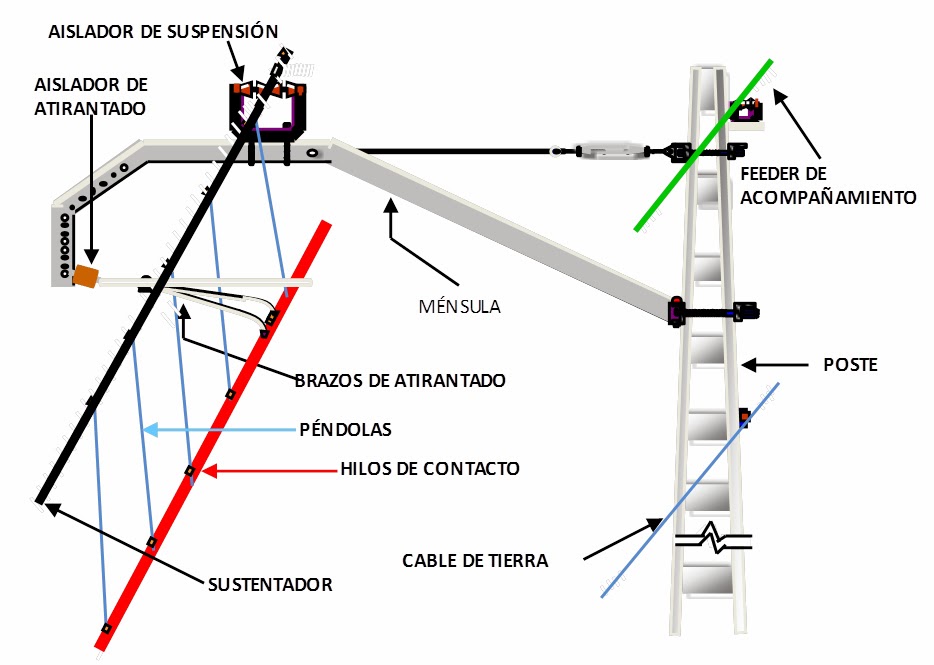It is called the “Catenary” to the curve described by a cable suspended
between two fixed points, placed at the same height:
In the railway, we call catenary to the assembly of elements that compose
the Contact Overhead Line (COL), which supplies the electrical trains through
the pantograph.
What we call “Messenger Wire” is the one forming the catenary curve on
which is suspended the contact-wire attached by the “droppers” of different
length to keep the contact-wire horizontal.
Parts composing the
Catenary System
In the railway, we can find different types of catenary according to the importance of the railway on which they are installed. Thus, we have:
- General-railway catenary and main station-railway, composed of:
- Messenger copper-wire of 153 mm2
- 2 contact-wires of copper of 107 mm2
- Secondary station-railway:
- Messenger steel-wire of 42 mm2
- 1 contact-wire of copper of 107 mm2
- Trolley or tramway:
- 1 contact-wire of copper of 107 mm2
Other kind of
catenary is the “rigid catenary”, used mainly in subways. This kind of catenary
consists of a rigid aluminum profile with the contact wire embedded. They need
very low loading gauge for the installation.
Compensated
catenary
The cables composing the catenary (messenger and contact wires) are subject
to length variations due to the thermal-dilatation caused by the temperature
changes. When the length of the cable changes, the geometry of the catenary
changes as well, changing the sag of the cables.
This effect is undesirable for the picking-quality of the pantograph, and
this is why special devices for the automatic regulation of the mechanical
tension.
 |
| Counterweight compensation in a general railway. |
 |
| Spring-compensation used with tramways. The spring can also be installed within a hollow mast. |
GO TO CHAPTER IX- Railway Loading Gauges
Full themes in the book -In paper and ebook-(Follow the link)
------------------------------------------------------------------
La Catenaria
Se llama catenaria a la curva que hace un cable suspendido entre dos puntos fijos, situados a la misma altura
En el ferrocarril, distinguimos los distintos tipos de catenaria en función de la importancia de la vía sobre la que se sitúe. Así tenemos:
Los cables conductores que forman la catenaria (sustentador e hilo[s] de contacto) se ven sujetos a variaciones de longitud debidas a la dilatación térmica producida por los cambios de temperatura. Al variar la longitud de los cables, la geometría de la catenaria se modifica, variando la flecha de los cables.
Este efecto es indeseable para la calidad de captación del pantógrafo, por lo cual se instalan elementos de regulación automática de la tensión mecánica.
IR A CAPÍTULO IX - Gálibos Ferroviarios
Temas completos en el libro - en papel y ebook (Siga este enlace)
Partes que componen el sistema de la catenaria
Tipos de catenaria
- Catenaria de vía general y vía principal de estación formada por :
- Sustentador de cobre de 153 mm2
- Dos hilos de contacto de cobre de 107 mm2 = 214 mm2
- Vía secundaria de estación:
- Sustentador de acero de 42 mm2
- Un hilo de contacto de cobre de 107 mm2
- Troley o tranviario:
- Un hilo de contacto de cobre de 107 mm2
Otro tipo de catenaria es la catenaria rígida, utilizada especialmente en metros. Está formada por un perfil rígido de aluminio que lleva incrustado el hilo de contacto. Necesitan de muy poco gálibo para su instalación.
Catenaria compensada
 |
| Compensación por contrapesos en vía general |
 |
Compensación por muelles utilizada en tranvías.
El muelle puede ir embebido en algún poste |
Temas completos en el libro - en papel y ebook (Siga este enlace)








No hay comentarios:
Publicar un comentario